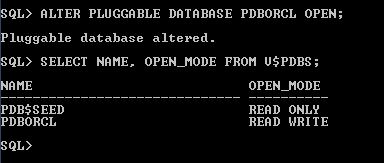So with a default installation of Oracle 12c, you get a container database as well as a pluggable database. The default name for the pluggable database is 'PDBORCL'.
For those of who you have installed Oracle Business Intelligence 12c would know that the metadata schemas for 12c cannot be installed on a container database. You will need a pluggable database to store these metadata schemas. With default installation you get a pluggable database by the object name 'PDBORCL'. So if you haven't written a database trigger statement to start your pluggable database on Oracle 12c what happens is that only the container database gets started. The result is that the web service is not able to connect and gather metadata from these two schema's and startup fails.
So here is how to check the status of your pluggable database and how to mount/open it. To check the status of the pluggable database, first open sqlplus,
once you have opened sqlplus login as the SYS user and once connected run the following query,
SELECT NAME, OPEN_MODE FROM V$PDBS;
 |
| Status of Pluggable databases. |
ALTER PLUGGABLE DATABASE ALL OPEN;
or
ALTER PLUGGABLE DATABASE PDBORCL OPEN;
 |
| Pluggable Database open command. |
